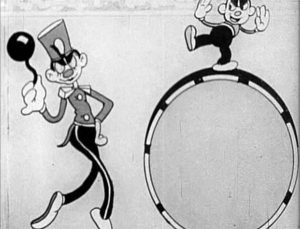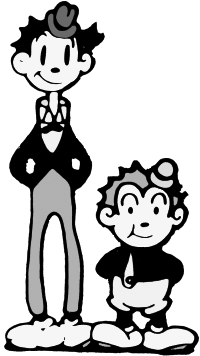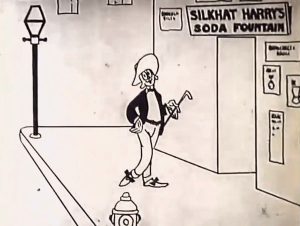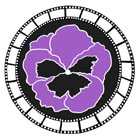For years, I often referred to Cartoon Research when I wanted to learn more about music in animation or found myself going down an anime rabbit hole (pun not intended). When I started the process of selecting films for my website, Queer Animation, I knew that Cartoon Research would have some leads. Steve Stanchfield and Fred Patten’s articles in particular were incredibly useful during the initial gathering process. Steve’s for pre-Code animation, and Fred’s for OVAs and films from Japan. I’m incredibly honored to be selected as a new columnist for Cartoon Research and cannot wait to share more of my insights on this site.
Let’s begin by looking at two early Van Beuren Tom & Jerry entries…
 Trouble (10/10/1931, dir. John Foster and George Stallings)
Trouble (10/10/1931, dir. John Foster and George Stallings)
Trouble contains the first queer-coded character in the Tom and Jerry series; by queer-coded, I mean a figure stylized as stereotypically gay through looks, behavior, or both. Although this character’s appearance is quite brief – around a whopping 3 seconds – for those interested in finding him, he is the only drummer shown in the marching band sequence when Tom and Jerry are advertising their legal practice.
Now, if you’re wondering what makes this particular character queer-coded, there are several reasons – let’s break down his design. First, the “teapotting” pose, where a character rests one hand on their hip with the elbow at a 45-degree angle, and their other arm is bent outward to the side. This extended arm usually has the pinkie pointed out. Next, is the physique. On average, early gay cartoon characters are reed-thin, and move in a swishy, pompous manner. For the drummer, this is demonstrated by his dainty, tiptoe walk cycle. Lastly, another common detail is a made-up face complete with eyelashes and cupid bow lips, a touch which blurs the line between defining masculinity and femininity. Separately, these characteristics do not necessarily indicate a character is queer. Combined, however, it showcases the stereotype of a queer coded man; a design not new to the 1930s, but instead something audiences could identify over a decade earlier during the silent era.
While silent animation contains fewer queer-coded characters compared to the 1930s, one of the more overt examples from the silent era appears in The Breath of a Nation (1919). Like the drummer in Trouble, this character is unnamed. His purpose in the story serves as a gag reveal from the effects of alcohol. When the audience first sees him before he enters the soda fountain for a treat, he is wafer-thin, and he shares many design similarities to the drummer in Trouble. However, upon leaving the shop, the alcohol he consumed transformed him into a burly (yet still effeminate) strongman. To further emphasize his otherness, he went into the soda shop because he was interested in having a fruit sundae. At that time, the term ‘fruit’ was a derogatory term for gay men, and demonstrates that as early as the late 1910s, queer-coding already had a visual shorthand understood by audiences.
By the early 1930s, due to the Pansy Craze, queer coded characters became popular and began to appear in more live action and animation. The Pansy Craze, a period which lasted roughly from the late 1920s to mid 1930s, was a time when audiences outside of the LGBTQ+ subculture, began to attend drag shows and or other explicitly camp and queer public performances. This fad occurred in cities like New York and San Francisco, and globally in Berlin, London, and Paris.
With Van Beuren located in New York City, the staff had a much higher chance of having an awareness of Pansy Craze performances. Considering the studio’s frequent references to popular culture and risqué jokes, and including queer coded animal characters – such as the effeminate goose seen in shorts like A Romeo Robin (1930) and The Animal Fair (1931) – the act of including a stereotypical human character who fits the image of the “ideal” Pansy Craze performer is a more direct example of Van Beuren capitalizing on the fad.
A concluding note: as evidenced by the drummer’s brief role and his simplistic design, it would still take some time before Van Beuren would evolve these queer coded characters and place them in more significant roles.
 Jungle Jam (11/14/1931, dir. John Foster and George Rufle)
Jungle Jam (11/14/1931, dir. John Foster and George Rufle)
Jungle Jam’s comedy contains the type of material that the Hays Code would have prohibited during its enforcement. Although the inclusion of Native cannibal stereotypes was not unique before or after this period, the racial interactions between the Chief and Jerry, and other integrated scenes would have been looked upon disapprovingly by the Code. These scenes toe the line of the Code’s “miscegenation” rule, specifically between the ways Black and white individuals interact on screen.
While adventuring in the jungle, Tom and Jerry are captured by a Native tribe. The Chief selects Jerry as the first one to be prepared for eating. When Jerry’s shirt comes undone, it is revealed that he has a dancing woman tattooed on his chest. The Chief becomes enraptured, watching the dancing woman. His interest in the tattoo shows his interracial heterosexuality and (more scandalously for that time) his attraction towards white women. Jerry’s trick saves him from being eaten, and the Chief expresses his appreciation by giving him a kiss on the cheek and temporarily sparing Tom and Jerry’s lives, leading to the whole tribe celebrating soon afterwards.
It’s tempting to interpret the Chief’s kiss as expressing “romantic” feelings toward Jerry. However, in contrast to the drummer character in Trouble, the Chief does not act effeminate nor share any of the other coded characteristics. Furthermore, since Tom and Jerry cannot communicate with the tribe, the Chief’s actions are his way of expressing gratitude and a desire for peace. This is evident by the fact the kiss on the cheek gag was incorporated in an earlier short, Polar Pals (1931), when Tom, trapped in a block of ice comes face to face with a walrus. In an unexpected twist, the walrus removes their tusks, which are revealed to be dentures, and kisses Tom’s cheek. A horn sound that resembles a “hello,” plays afterward to let the frightened Tom know he is not in danger. However, Tom does not become calm; instead, he remains anxious during the encounter.

Unlike Polar Pals, there is a follow-up joke in Jungle Jam. When the Chief goes to kiss Jerry, Jerry is resistant. Afterwards, however, Jerry shows no sign of disgust, and instead, he becomes coy. He averts his eyes only to sneak a look back towards the Chief, mutter a flirtatious “Oh Chief,” and let out a sigh. The shot concludes with a comical cuckoo sound effect as Jerry coyly looks back at the Chief one more time, thus letting the audience know that Jerry’s behavior is not “normal”, and he is reacting absurdly.
This scene is ultimately a one-off gag, and there are no further instances of queer representation or similar jokes in this short. Soon afterwards, when everyone is celebrating, Jerry’s heterosexuality is reinforced. As shown by him and Tom dancing with women from the tribe. This second, longer integrated scene between the Black and white characters would be another instance of the film containing “scandalous” content, and if released a few years later not passed by the Code. While all the scenes I have discussed are quite brief, the fact these would have failed the Code’s guidelines demonstrates how much of an impact the Code had even on animation and restricting what could be allowed.
Next Time: More Van Beuren observations.
(Special thanks to David Gerstein)





































I’ve never heard the term “Pansy Craze” before, but I guess anyone who’s ever seen the musical “Cabaret” would be aware that there was such a thing, notably in Berlin. I’m reminded of a scene in Sinclair Lewis’s 1929 novel “Dodsworth”, in which Mr. and Mrs. Dodsworth are shown around Berlin by a young count who takes them to a gay nightclub called Die neuste Ehe (“the latest in matrimony”), where he seems to be a familiar face. When he sees that the Dodsworths (who hail from the conservative Midwestern city of Zenith) are aghast at the spectacle, he takes them away and apologises, claiming that he had no idea what sort of place it was. The incident suggests that it would not have been unthinkable for a middle-aged straight couple to go to such a club for the entertainment.
My mother’s family emigrated from Germany to the United States in the 1920s, and they were active in a social club for German immigrants until it was forced by the government to disband at the onset of World War II. This club regularly staged drag shows; we had an 8×10 photo of my grandfather performing in one of them, dressed up as Marlene Dietrich. (He had apparently shaved at least one of his legs for the occasion.) This form of entertainment may have originated in gay culture but was by no means confined to it.
I would be very interested in anything you might have to say about the German cartoons of this period. As for Tom and Jerry, I’m more familiar with the stereotypes in their later cartoons, such as “Pots and Pans”, “The Magic Mummy”, and especially “Dough Nuts” (with its “Pansy Brand Cream Puffs”).
Hi Paul! That’s quite interesting about that scene from Sinclair Lewis’ book, and yes, Berlin had quite a thriving queer community. There was even a place named after Mickey Mouse himself, the lesbian bar “Café Mickimaus.” Marlene Bellissimo posted on YouTube “The Lesbian Mickey Mouse Café | Dreamsounds” which contains some excellent research on the German bar itself, and the lesbian community’s connection with Mickey Mouse in both Germany and the United States.
That is incredibly interesting about the social club! In fact, during World War II one of the methods to boost US morale was performances which included drag. One example includes the Broadway musical later adapted to film “This Is the Army.” The film includes the drag numbers “Ladies of the Chorus” the Stage Door Canteen scene, and one actor briefly in “That’s What the Well Dressed Man in Harlem Will Wear.”
As for German cartoons, I do not know any (yet) that have survived from this period, and it can be a bit difficult to find a concise list of German animation from this period online. I’ve seen several of the later 30s animated advertisements, and from the 20s Lotte Reiniger’s work (which I do want to re-watch) but would like to watch more from the early 30s. A place that would have preserved gay animation from this period would have been the Institut für Sexualwissenschaft (this may not be the exact translation but “Institute of Sexology”) which unfortunately was looted and destroyed during nazi rule.
This will be a valuable addition to the blog. So often queer representation in the classic cartoons was a subtle or subliminal thing, and one that isn’t often explored, from the vague effeminacy of the various Prince Charmings, and screwball characters kissing and flirting with their adversaries, to the complex relationship of Popeye and Bluto. Though an overt depiction of “gay” was taboo during the Production Code (unless tragic or a quick joke), there were ways around it.
Thank you for the kind words! There’s so much to examine from the Golden Age of animation, although I definitely have a soft spot for the screwball characters.
It’s always great to see such informative posts here on Cartoon Research with a brand new outlook on classic early animation. I’m looking forward to the next piece in this series.
Thank you! I’m glad you enjoyed the first part, cannot wait to continue writing more for this series.
Hey Esther, I really enjoyed this article and look forward to followups from you! There’s a lot just from classic animation, particularly the NY crowd (a friend once joked that every other NY cartoon from the early 30s has one, some more subtle than others). I’ve also seen one late silent currently out of circulation prominently featuring a very queerly coded man that I can share with you privately, if needed. If you haven’t, you may want to reach out to my friend Matthias Smith, whose also done research into queer coded characters in early animation
Thank you! I agree about NY cartoons, and certainly don’t find it a coincidence so many queer coded characters appeared in these shorts considering how popular the Pansy Craze was there.
I always enjoy learning more about the silent era, and would be interested to know which short it could be. I can be contacted at queeranimation@gmail.com to discuss it further.
I’ll definitely reach out to Matthias, I always enjoy talking with a fellow animation researcher!
First time commenter here. This is an unexpected – and very welcome – change-up for this blog! For too long, people have been immersed in the status quo that “old cartoons” and “what we consider acceptable today” are utterly incompatable. The fact that I’ve never even heard of the Pansy Craze is proof that these kinds of things oughta be taught, and taught loud. Looking forward to more of this feature.
Thank you! Glad you enjoyed reading about the Pansy Craze. If you are interested in learning more about the period (though focusing more on New York) I recommend “Gay New York: Gender, Urban Culture, and the Making of the Gay Male World, 1890-1940” by George Chauncey.
I’ll have to check that out, later down the line. Thanks for the rec!
That’s an excellent book! Definitely recommended!
As someone who has unfortunately had far-right radicalization in the past, I’m still struggling and i’m very sensitive when i see things like transphobia, but i’m happy to see Cartoon Research talking about homosexuallity
What do you think about Steven Universe and all recent LGBT oriented cartoons?
Steven Universe is fantastic! I was a big fan of the show when it was airing, and I consider it a marker of sorts for more LGBTQ+ visibility in children’s television.
Truthfully, I am a bit behind when it comes to more recent cartoons, as most of my focus has currently been on films and shorts. I am glad though that more showrunners are allowed to show characters explicitly part of the LGBTQ+ community, rather than having to release a statement after the show concluded. I do try to keep tabs about recent characters or scenes to the best of my ability though.
In vaudeville and burlesque of the 1910’s – 1930’s, “the nance” was a common stock character. A “nance” was a male figure with effeminate, “sissy” mannerisms and often speaking with a lisp, and using lots of double-entendres. Most often, it was a “-face” performance; that is, the actor was almost always heterosexual (just as actors would perform “different” ethnic characters, “blackface” being the most notorious).
What an excellent point. I’ve always found the “nance” character quite interesting since they are less examined. I only learned about it myself when I saw “The Nance” on Broadway. Fortunately, there was a recording of the show made, and it is currently available to view on YouTube.
Thank you, Esther. This is great! I look forward to see more.
I have a question about the kiss in “Jungle Jam”, and how it was read by the audience. It could be that it was meant to evoke a wink at gayness, in audiences that were aware of it. Or, for folks who had never heard of homosexuality (and there were many of them then), it would just be read as an absurd, topsy-turvy situation. Is there a way to read the scene and figure out which of the two the animators meant, and how the scene was perceived?
I’ve wondered the same about Bugs Bunny in drag, too.
Typically with risqué humor there will be a group where it will go over their head and need it to be explained and another that understands the original intention. Since the 30s (and especially the pre-Code era) were often not particularly subtle in their jokes, making it much easier to be able to tell what the original intention was.
To elaborate a bit further as I didn’t mention it in my examination, Tom and Jerry in Jungle Jam aren’t particularly talkative characters. To include this as one of Jerry’s few speaking lines shows how deliberate the writers were with this joke. I do feel that with queer theory there are times when people can “overread” the media, but in this case, I would argue the crew were well aware and wanted to include a sly wink to those in the know.
Yes, Bugs Bunny is quite an interesting character, though discussing him here would turn this into an absurdly long comment! Although I can confirm that I plan on examining him at some point for this series.
Congratulations Esther! I look forward to your ongoing observations and commentaries. I am fascinated by the infitinte ways in which ways of being human are shared, hinted at, hidden, joked about, approval sought, etc. A fertile field to be sure, and in cartoon form to boot! Who could ask for more?
I know the topic is animation — but now I can’t help wanting to watch one of those classic black and white scenes between Eric Blore and Edward Everett Horton.
Thank you David! I agree with your insights about human nature, it’s easy for people to overlook these cartoons even though they did provide a fantastic peek into American culture at the time, just often even zanier, or depending on who you ask perhaps even more sane! Enjoy the future classic film watch, I’m quite a fan of Franklin Pangborn myself.
Hello Esther – I not only enjoyed your article, but I also am delighting with your website and want to explore it further. I’ve already watched a number of animation entries you pointed out to me, all truly superb and fascinating. I must do more browsing, but some are/were clearly worthy of Academy Award honors, if neglected perhaps because of their Queer content? – In particular, “Pedro and Tony” – combining media including excellent stop-motion, using animal characters, psychologically insightful about relationships – and absolutely hilarious! https://queeranimation.omeka.net/exhibits/show/sexuality-and-gender/item/204
Your website should be on everyone’s list of essential animation resources – as should you as an Advisor, Consultant and Researcher, for any subject matter, not only barrier breaking ones such as Queer Animatoin. Hope we can do some programming together in future..
–Dr Jud Newborn, Producer/Curator, Long Island NY’s Cinema Arts Centre. (Producer/Creative & Historical Consultant for 5 min, award-winning animated short designed by Bill Plympton, “Ingrid Pitt: Beyond the Forest” – Holocaust subject matter)
Jud, thank you for the kind words. I’d say it depends on a variety of factors, as some works were more widely shown and recognized than others on the festival circuit. It’s reaching (and appealing) to a wider, mainstream audience that can become difficult.
I am so glad you enjoyed “Pedro + Tony?” It’s one of my favorites on the site and deserves much more attention and love. Also, I agree with you, doing a program together would be wonderful!
REALLY happy you’re here. It will be nice to have some queer inclusion and acceptance. Welcome aboard.